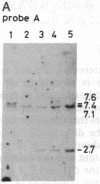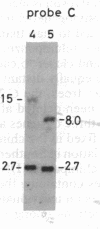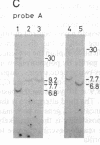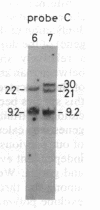Abstract
Molecular genetic analyses of the young pseudogenes of the immunoglobulin C epsilon genes were carried out to obtain qualitative evidence for the phylogenetic branching pattern of hominoid primates. We found that Old World monkeys had two C epsilon genes, one of which was processed. Among the hominoids examined only the gorilla and human genomes contained three C epsilon genes: an active, a truncated, and a processed gene. Other hominoids so far examined, including chimpanzee, contained two C epsilon genes: one active and the other processed. These results suggest that the processed C epsilon pseudogene was generated before the divergence between Old World monkeys and hominoids and that the gorilla is more closely related to man than the chimpanzee is, unless the chimpanzee has lost the C epsilon 2 gene after the divergence of this species.
Full text
PDF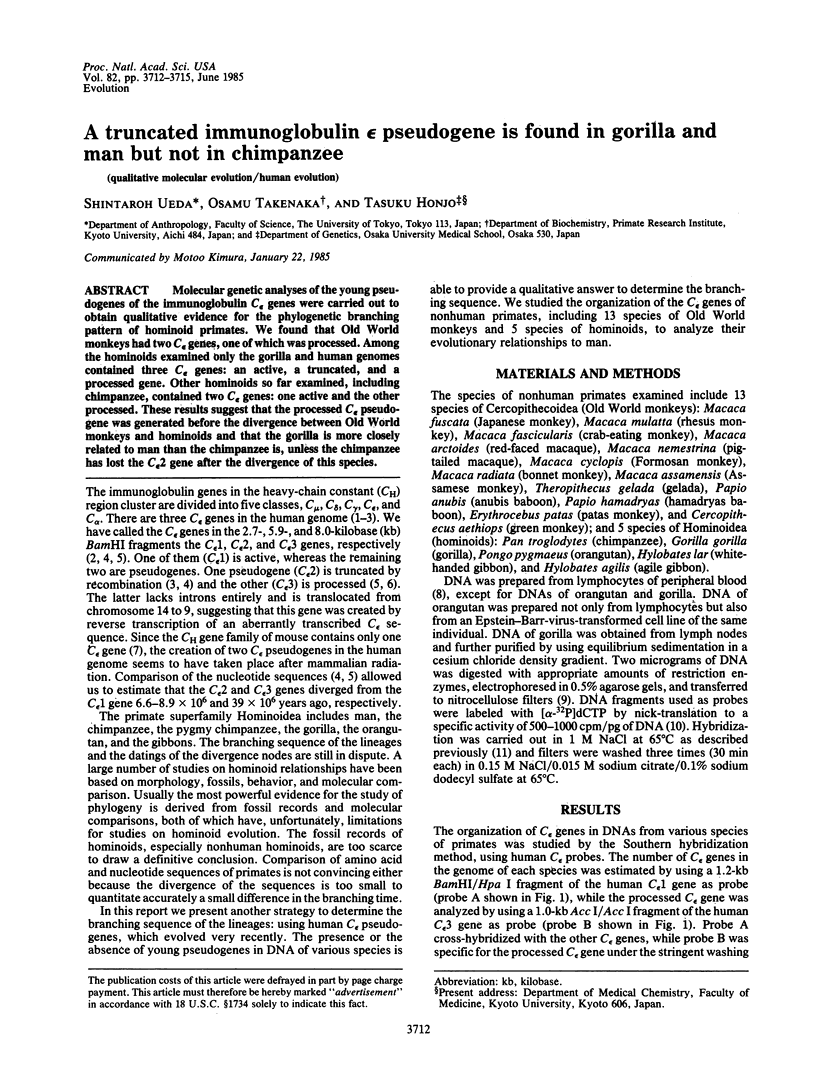
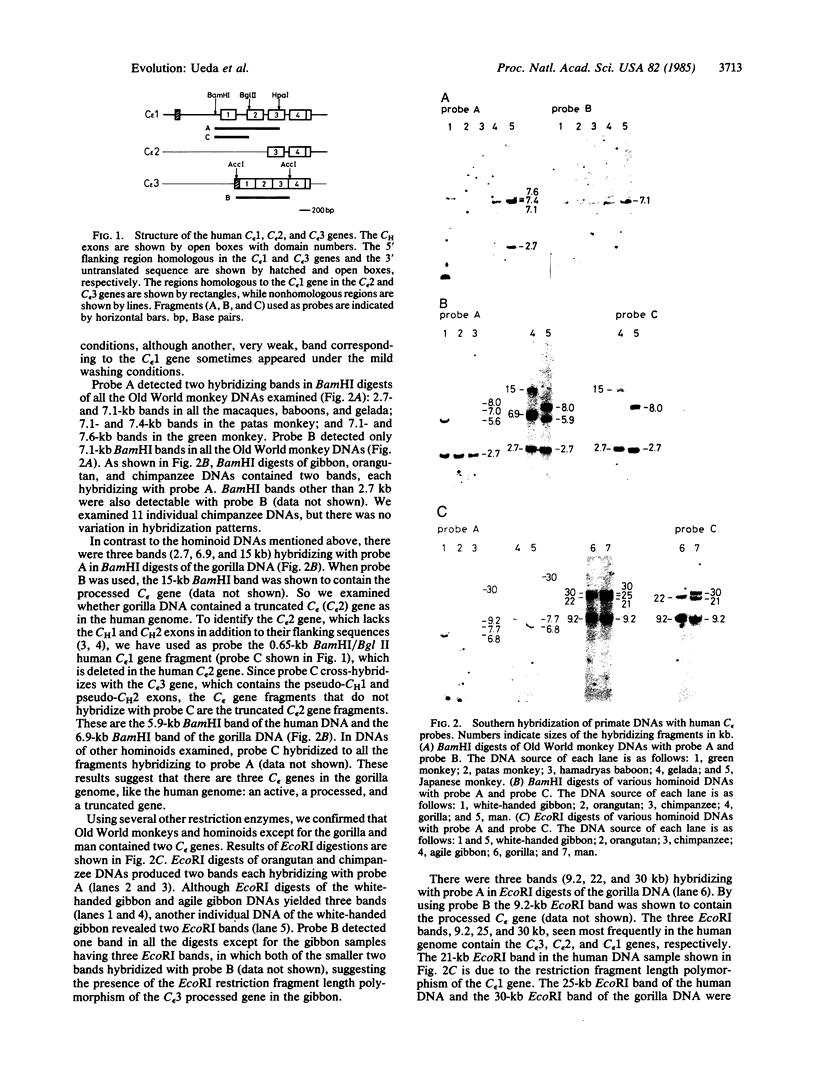
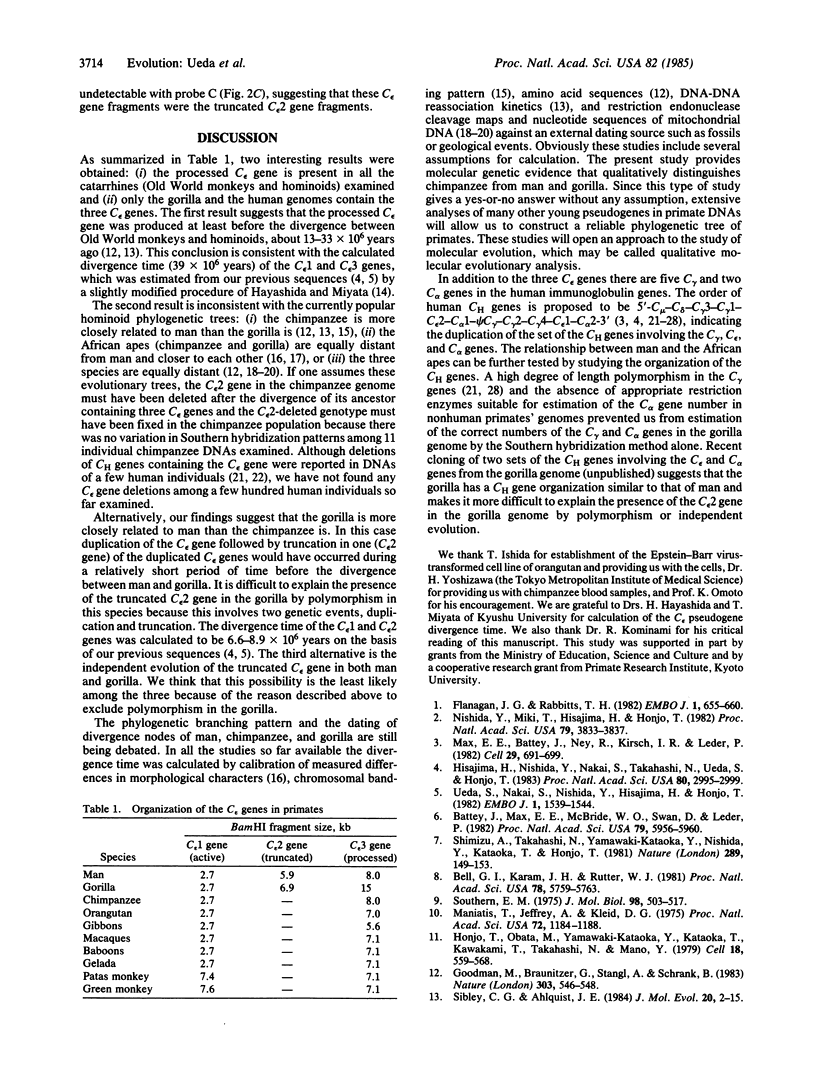

Images in this article
Selected References
These references are in PubMed. This may not be the complete list of references from this article.
- Battey J., Max E. E., McBride W. O., Swan D., Leder P. A processed human immunoglobulin epsilon gene has moved to chromosome 9. Proc Natl Acad Sci U S A. 1982 Oct;79(19):5956–5960. doi: 10.1073/pnas.79.19.5956. [DOI] [PMC free article] [PubMed] [Google Scholar]
- Bech-Hansen N. T., Linsley P. S., Cox D. W. Restriction fragment length polymorphisms associated with immunoglobulin C gamma genes reveal linkage disequilibrium and genomic organization. Proc Natl Acad Sci U S A. 1983 Nov;80(22):6952–6956. doi: 10.1073/pnas.80.22.6952. [DOI] [PMC free article] [PubMed] [Google Scholar]
- Bell G. I., Karam J. H., Rutter W. J. Polymorphic DNA region adjacent to the 5' end of the human insulin gene. Proc Natl Acad Sci U S A. 1981 Sep;78(9):5759–5763. doi: 10.1073/pnas.78.9.5759. [DOI] [PMC free article] [PubMed] [Google Scholar]
- Brown W. M., Prager E. M., Wang A., Wilson A. C. Mitochondrial DNA sequences of primates: tempo and mode of evolution. J Mol Evol. 1982;18(4):225–239. doi: 10.1007/BF01734101. [DOI] [PubMed] [Google Scholar]
- Ellison J., Hood L. Linkage and sequence homology of two human immunoglobulin gamma heavy chain constant region genes. Proc Natl Acad Sci U S A. 1982 Mar;79(6):1984–1988. doi: 10.1073/pnas.79.6.1984. [DOI] [PMC free article] [PubMed] [Google Scholar]
- Ferris S. D., Wilson A. C., Brown W. M. Evolutionary tree for apes and humans based on cleavage maps of mitochondrial DNA. Proc Natl Acad Sci U S A. 1981 Apr;78(4):2432–2436. doi: 10.1073/pnas.78.4.2432. [DOI] [PMC free article] [PubMed] [Google Scholar]
- Flanagan J. G., Lefranc M. P., Rabbitts T. H. Mechanisms of divergence and convergence of the human immunoglobulin alpha 1 and alpha 2 constant region gene sequences. Cell. 1984 Mar;36(3):681–688. doi: 10.1016/0092-8674(84)90348-9. [DOI] [PubMed] [Google Scholar]
- Flanagan J. G., Rabbitts T. H. Arrangement of human immunoglobulin heavy chain constant region genes implies evolutionary duplication of a segment containing gamma, epsilon and alpha genes. Nature. 1982 Dec 23;300(5894):709–713. doi: 10.1038/300709a0. [DOI] [PubMed] [Google Scholar]
- Flanagan J. G., Rabbitts T. H. The sequence of a human immunoglobulin epsilon heavy chain constant region gene, and evidence for three non-allelic genes. EMBO J. 1982;1(5):655–660. doi: 10.1002/j.1460-2075.1982.tb01223.x. [DOI] [PMC free article] [PubMed] [Google Scholar]
- Goodman M., Braunitzer G., Stangl A., Schrank B. Evidence on human origins from haemoglobins of African apes. Nature. 1983 Jun 9;303(5917):546–548. doi: 10.1038/303546a0. [DOI] [PubMed] [Google Scholar]
- Hayashida H., Miyata T. Unusual evolutionary conservation and frequent DNA segment exchange in class I genes of the major histocompatibility complex. Proc Natl Acad Sci U S A. 1983 May;80(9):2671–2675. doi: 10.1073/pnas.80.9.2671. [DOI] [PMC free article] [PubMed] [Google Scholar]
- Hisajima H., Nishida Y., Nakai S., Takahashi N., Ueda S., Honjo T. Structure of the human immunoglobulin C epsilon 2 gene, a truncated pseudogene: implications for its evolutionary origin. Proc Natl Acad Sci U S A. 1983 May;80(10):2995–2999. doi: 10.1073/pnas.80.10.2995. [DOI] [PMC free article] [PubMed] [Google Scholar]
- Honjo T., Obata M., Yamawaki-Katoaka Y., Kataoka T., Kawakami T., Takahashi N., Mano Y. Cloning and complete nucleotide sequence of mouse immunoglobulin gamma 1 chain gene. Cell. 1979 Oct;18(2):559–568. doi: 10.1016/0092-8674(79)90072-2. [DOI] [PubMed] [Google Scholar]
- Krawinkel U., Rabbitts T. H. Comparison of the hinge-coding segments in human immunoglobulin gamma heavy chain genes and the linkage of the gamma 2 and gamma 4 subclass genes. EMBO J. 1982;1(4):403–407. doi: 10.1002/j.1460-2075.1982.tb01182.x. [DOI] [PMC free article] [PubMed] [Google Scholar]
- Lefranc M. P., Lefranc G., Rabbitts T. H. Inherited deletion of immunoglobulin heavy chain constant region genes in normal human individuals. Nature. 1982 Dec 23;300(5894):760–762. doi: 10.1038/300760a0. [DOI] [PubMed] [Google Scholar]
- Maniatis T., Jeffrey A., Kleid D. G. Nucleotide sequence of the rightward operator of phage lambda. Proc Natl Acad Sci U S A. 1975 Mar;72(3):1184–1188. doi: 10.1073/pnas.72.3.1184. [DOI] [PMC free article] [PubMed] [Google Scholar]
- Max E. E., Battey J., Ney R., Kirsch I. R., Leder P. Duplication and deletion in the human immunoglobulin epsilon genes. Cell. 1982 Jun;29(2):691–699. doi: 10.1016/0092-8674(82)90185-4. [DOI] [PubMed] [Google Scholar]
- Migone N., Oliviero S., de Lange G., Delacroix D. L., Boschis D., Altruda F., Silengo L., DeMarchi M., Carbonara A. O. Multiple gene deletions within the human immunoglobulin heavy-chain cluster. Proc Natl Acad Sci U S A. 1984 Sep;81(18):5811–5815. doi: 10.1073/pnas.81.18.5811. [DOI] [PMC free article] [PubMed] [Google Scholar]
- Nishida Y., Miki T., Hisajima H., Honjo T. Cloning of human immunoglobulin epsilon chain genes: evidence for multiple C epsilon genes. Proc Natl Acad Sci U S A. 1982 Jun;79(12):3833–3837. doi: 10.1073/pnas.79.12.3833. [DOI] [PMC free article] [PubMed] [Google Scholar]
- Shimizu A., Takahashi N., Yamawaki-Kataoka Y., Nishida Y., Kataoka T., Honjo T. Ordering of mouse immunoglobulin heavy chain genes by molecular cloning. Nature. 1981 Jan 15;289(5794):149–153. doi: 10.1038/289149a0. [DOI] [PubMed] [Google Scholar]
- Sibley C. G., Ahlquist J. E. The phylogeny of the hominoid primates, as indicated by DNA-DNA hybridization. J Mol Evol. 1984;20(1):2–15. doi: 10.1007/BF02101980. [DOI] [PubMed] [Google Scholar]
- Southern E. M. Detection of specific sequences among DNA fragments separated by gel electrophoresis. J Mol Biol. 1975 Nov 5;98(3):503–517. doi: 10.1016/s0022-2836(75)80083-0. [DOI] [PubMed] [Google Scholar]
- Takahashi N., Ueda S., Obata M., Nikaido T., Nakai S., Honjo T. Structure of human immunoglobulin gamma genes: implications for evolution of a gene family. Cell. 1982 Jun;29(2):671–679. doi: 10.1016/0092-8674(82)90183-0. [DOI] [PubMed] [Google Scholar]
- Ueda S., Nakai S., Nishida Y., Hisajima H., Honjo T. Long terminal repeat-like elements flank a human immunoglobulin epsilon pseudogene that lacks introns. EMBO J. 1982;1(12):1539–1544. doi: 10.1002/j.1460-2075.1982.tb01352.x. [DOI] [PMC free article] [PubMed] [Google Scholar]
- Yunis J. J., Prakash O. The origin of man: a chromosomal pictorial legacy. Science. 1982 Mar 19;215(4539):1525–1530. doi: 10.1126/science.7063861. [DOI] [PubMed] [Google Scholar]



